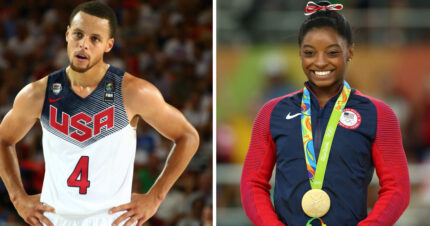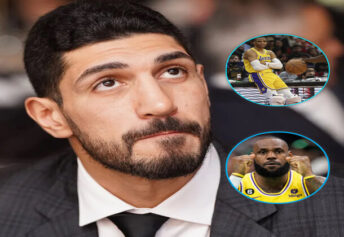Los Angeles Lakers star LeBron James made a statement with his wardrobe, long before his team was scheduled to take on the Utah Jazz in an ESPN-televised game to cap off the 5th day of NBA action at the Walt Disney World campus.
James pulled up to Monday night’s game with a long-sleeved black t-shirt with graphic the left side of the chest with a stopwatch that is stopped on 8 minutes and 46 seconds, the amount of time that police officer Derek Chauvin spent with his knee on Floyd’s neck.
It was in deference of the obvious malaise of the investigation and the seemingly unending racist views apparent in government and the current administration.
For the first time, two police body camera videos show the deadly encounter with George Floyd but from the officers’ perspective.
The video is gut-wrenching.
I’m the bodycam footage of George Floyd’s arrest he said he’d have trouble breathing if they put him in the car, complained that he couldn’t breathe when cops weren’t touching him, and then said wanted to lay on the ground.
“I wanna lay on the ground.” pic.twitter.com/urkgncHlME
— Ian Miles Cheong (@stillgray) August 3, 2020
Floyd is approached while seated in his car by an officer using a flashlight end to tap on the window.
As many people would do, Floyd panics and opens the door instead of rolling down the window. He is asked to show his hands but he isn’t doing it fast enough for the officer.
He immediately pleads with the officer not to shoot him once a gun is brandished by former officer Thomas Lane for no other reason except that the officer feels as if his commands are being responded to in delayed fashion.
Floyd reveals that he has been shot before and that he has recently buried his mother. His anxiety at the way the cop approached is clear and his fear is evident.
You can’t blame him at all for that very real fear of death by police for simply being tall and Black.
Floyd can be heard begging for help and calling for his mother for several minutes. His friends exit the car and comply with the officer’s unwarranted request for information: names, ID cards, and the like.
https://twitter.com/aimeecarrero/status/1290439350191362050?s=20
It feels wrong to the core as the only reason that was given is their search “for what’s going on.”
Later in the footage, Floyd drops to the ground as officers lead him toward a squad car. He says he is claustrophobic and won’t be able to breathe if they place him inside.
Still, he reluctantly complies but just doesn’t want to be fully in the back seat. He is already handcuffed. Still, the officer’s viewpoint is that this is yet another turn at resistance and Floyd must be neutralized.
He asks to be put on the floor and the officers resist that.
However, his fear of claustrophobia compels him to will his body onto the floor even though he is being manhandled from both sides of the car at this point.
He is legitimately afraid for his life. He had the right to be because, in minutes, his life will be over.
Why wasn’t the George Floyd police officer body cam footage released immediately????
— Ashley St. Clair (@stclairashley) August 4, 2020
A Minneapolis Slave-Catch
“I [patroller’s name], do swear, that I will as searcher for guns, swords, and other weapons among the slaves in my district, faithfully, and as privately as I can, discharge the trust reposed in me as the law directs, to the best of my power. So help me, God.”
-Slave Patroller’s Oath, North Carolina, 1828.
You cannot discuss policing in early America without mentioning the slave patrols. The American South relied on these patrols as one of the earliest and most prolific forms of early policing.
According to the Law Enforcement Museum, organized policing was one of the many types of social controls imposed on enslaved African Americans in the South.
Slave patrols were no less violent in their pursuit to control African Americans. They functioned as domestic terrorists and were legally compelled to do so by local authorities. It was considered a civic duty.
According to historian Sally Hadden in her book, Slave Patrols: Law and Violence in Virginia and the Carolinas, “The history of police work in the South grows out of this early fascination, by white patrollers, with what African American slaves were doing. Most law enforcement was, by definition, white patrolmen watching, catching, or beating black slaves.”
Before the Blue Lives Matter contingent negates the argument that George Floyd’s killers weren’t acting out of a slave patrol mentality, read the Minneapolis police department definitions of their actions.
According to Minneapolis Police Department Code 5-302 USE OF FORCE DEFINITIONS (10/16/02) (10/01/10):
Active Aggression: “Behavior initiated by a subject that may or may not be in response to police efforts to bring the person into custody or control. A subject engages in active aggression when presenting behaviors that constitute an assault or the circumstances reasonably indicate that an assault or injury to any person is likely to occur at any moment.” (10/01/10) (04/16/12)
Active Resistance: “A response to police efforts to bring a person into custody or control for detainment or arrest. A subject engages in active resistance when engaging in physical actions (or verbal behavior reflecting an intention) to make it more difficult for officers to achieve actual physical control.” (10/01/10) (04/16/12)
Going further, according to Code 5-301.03 MEDICAL TREATMENT AND USE OF FORCE (07/17/20):
“Any sworn MPD employee who uses force shall, as soon as reasonably practical, determine if anyone was injured and render medical aid consistent with training and request Emergency Medical Service (EMS) if necessary (in accordance with P&P 7-350). Some force control options involve or require additional medical attention.”
Murder in the First Degree
Officers Derek Chauvin, Thomas Lane, Tou Thao, and J Alexander Kueng may have been taught to be suspicious of men that look like George Floyd at the academy.
Perhaps culturally, they looked suspicious and acted suspiciously when in reality his fear immobilized him from making extremely rational decisions that they would understand.
Still, it must be noted that in America, the history of policing Black people has roots in slave patrolling and the biases remain.
Insensitivity leading to death has always been a part of America’s history with persons of color. However, it is intolerable and must not go unpunished.
[Image description: six men, all of them POC, all wearing dark-grey pants & black shirts that say “Black Lives Matter” in white all-caps text, take a knee on a basketball court. A discarded jersey on the far left indicate they are LA Lakers. 2nd from right might be LeBron James?] https://t.co/6FCdF4kpqC
— MASHFanficChick (xe/hir) is on semi-hiatus (@MASHFanficChick) July 31, 2020
When you have statements from people like Senator Tom Cotton (R-Ark) who recently stated that slavery was a “necessary evil” then you see how George Floyd’s life didn’t matter in this instance.
There must be a reckoning and nothing less than First-degree murder must be handed down to the officers.
But the true indictment is on the system, one that must be rebuilt with inclusion and mediation in mind. Until then, there will undoubtedly be more George Floyd’s unless the slave catcher mentality is fully eradicated from the annals of American policing.



